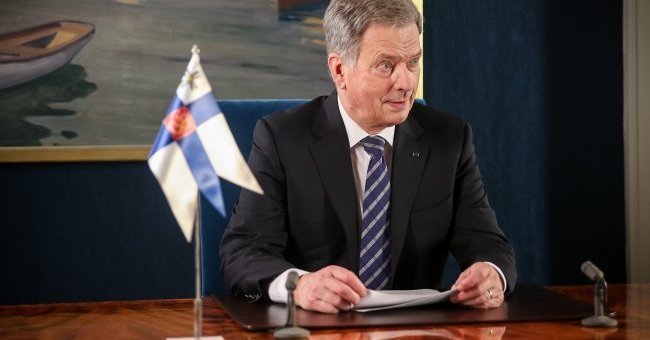The Suomen Tasavallan Presidentti [1]
The Finnish Head of State is elected for a six-year term. This election is held by direct universal suffrage since 1994 and will take place at the end of January for the first round (two weeks later for the second round). The elected candidate takes office at the beginning of the month following his election. In the case where only one person is a candidate for the presidency, the ballot is not organised, and the only candidate is elected ex officio to power. The President of the Republic cannot exercise more than two consecutive terms. Candidates, who must necessarily be born Finnish citizens, can be nominated by a party or a group of at least 20,000 voters.
The Finnish President undertakes the country’s foreign policy and defence, he is the commander-in-chief of the armies. However, he remains a stranger to the internal affairs over which he has no power. On 21 October 2011, a constitutional reform adopted by the Eduskunta (the unicameral Parliament of Finland) changed the presidential powers, putting in the Constitution that Finland is represented in the European Union by its Prime Minister.
Candidates for the Presidency of the Republic of Finland
8 people are officially running for the presidency, including several MEPs.
Sauli Niinistö, 69, independent, candidate for his own succession. Former Minister of Justice (1995-1996) and Finance (1996-2003), and former President of the Parliament (2007-2011), he was elected President of the Republic in 2012, at the head of the conservative and liberal Party of the national coalition (KOK).
Pekka Haavisto, 59, candidate of the Greens (VIHR), second political force of the country. Former Minister of the Environment (1995-1999), he also worked at the UN. In 2005, he became the representative of the European Union in Sudan, and was elected to the parliamentary elections in 2011.
Laura Huhtasaari, 38, candidate of the True Finns party, far right. Member of the Committee on Legal Affairs, the Committee on Education and Culture, as well as the Finnish delegation at the Nordic Council.
Paavo Väyrynen, 71, candidate of the Citizens Party. Former president of the Centre Party (KESK). He has been MEP since 2014.
Matti Vanhanen, 62, Centre Party candidate (KESK). Former Vice-Chairman of the Environment Committee and the KESK Parliamentary Group (1994-2001), former Prime Minister (2003-2010), he participated in the Convention on the Future of Europe between 2002 and 2003.
Merja Kyllönen, 40, candidate of the Alliance of the left (Vas). Former Minister of Transport (2011-2014), she was elected MEP in the last elections of May 2014.
Tuula Haatainen, 57, candidate of the Social Democratic Party of Finland (SDP). Former Minister of Social Affairs and Health (2005-2007) and Education (2003-2005), she has been working since 2010 as Director of the Local Government Representative Organization as an employer.
Nils Torvalds, 72, candidate of the Swedish People’s Party of Finland. He has been MEP since 2012.
The European question at the heart of the electoral campaign
As the favourite candidate of the election, Sauli Niinistö faces a strong Europhobic and Eurosceptic movement revealed by the presence of several candidates proposing an exit from Finland of the European Union. Paavo Väyrynen stands out from his former Centre Party particularly on European issues by proposing the return of a national currency for his country. But the populist Laura Huhtasaari is probably the most dangerous in terms of votes, but also in view of the European common values: she estimated last February that the European Union will collapse, and that Finland should leave it. Likewise, she opposes Finland’s membership of NATO, even though she supports a cooperation with the alliance. Like Donald Trump she supports, the candidate of the True Finns party calls for the withdrawal of the Paris Agreement on the climate.
As in the last election, the attitude towards the European Union has become an essential cleavage of the presidential election and the political debates in Finland.
However, the presence of Eurosceptic candidates in the Finnish presidential election does not pull the country out of its deep involvement in the European construction, and its overwhelming attachment to EU membership [2]. On this matter, it is a factor of concern about possible Russian interferences that could lead to the isolation of Finland from the European Union, as well as the obstruction of NATO-related discussions, which led, last October, the Security Committee of the Finnish Ministry of Defense to consider different scenarios for the conduct of this election.
Sauli Niinistö, a favourite for the presidential election
Two weeks before the first round, Sauli Niinistö is the big favourite. According to pollsters, he could even win from the first round of January 28th, winning the required absolute majority. The gap between the outgoing President of the Republic and the other candidates has grown steadily in recent weeks because of a growing popularity that has even allowed him to run without support from any political party.
According to the latest opinion poll undertaken, 70% of respondents support the reelection of the outgoing President of the Republic. His main rival, Pekka Haavisto, would only gather about 14% of the vote, equalling his honourable score in 2012, and making the ecologist party the second largest political force in the country. This score can be explained in particular by the good relations established by President Niinistö with Vladimir Putin’s Russia during his previous term. Meanwhile, Eurosceptic candidates would collect only a small 6% of the vote.
While the 2015 legislative elections had resulted in the formation of a coalition government with a far-right party, this vote seems to reflect a political weakening of the True Finns party. Next year, the Finns will again be called to the polls, which could end the presence of the far right in the current government.
The suspense surrounding this election is, thus not considerable, although it will be interesting to follow the results in the light of the potential repercussions for the Union, and the European policy that will be led by Finland during this next mandate. Barring a surprise, Finland will elect again Sauli Niinistö as President of the Republic for the next 6 years.


Follow the comments: |
|
